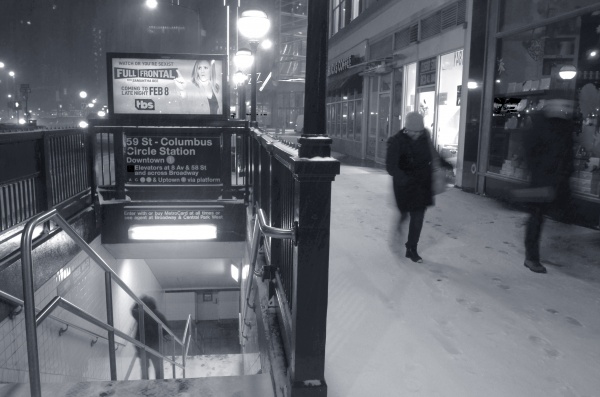Snow Emergencies Need Better Responses
Winter storm Jonas sets in in the early hours of Saturday morning at 12:30 A.M. (ANDIE ZIMMERMAN/ THE OBSERVER)
February 13, 2016
If I have learned anything from being born and raised in New York City and from going to public schools, it is that you can almost always expect to be disappointed by the response of the City. New York is infamous for having relatively few snow days over the last few years. According to Animal New York, there have been only 11 snow days since 1978. In the 2000s alone, there have only been five snow days so far. Unfortunately, the city administration has often showed that it was not up to the task of accurately declaring a snow day, or providing grace periods for its beleaguered boroughs. Former Mayor Michael Bloomberg prematurely called snow days in March of 2001 for a storm that only dropped 3.5 inches of snow, and in March of 2009, when he closed schools in response to a storm of 8.3 inches. For every premature closing there have been events where the City, in the face of a large snowstorm, has kept schools opened and not declared snow days.
This brings us to the current aftermath of Winter Storm Jonas, a storm that rivals many past ones as one of the biggest snowstorms on the East Coast. For the city itself, it has been the second-largest snowstorm to strike. NYC received almost 27 inches of snow, and even greater amounts were reported in areas of Queens such as Jackson Heights. At least 14 states on the East Coast received at least one foot of snow in total, a clear indicator of the strength and extent of the storm. With all these facts in mind, it is understandable why New Yorkers were infuriated at the instructions provided by Governor Andrew Cuomo and Mayor Bill de Blasio, and the blatant lack of attention to detail provided to the outlying boroughs—particularly Queens and Staten Island, where streets were still blanketed with snow; untouched by the ploughs. Also controversial was the NYPD declaration of a travel ban, an act that some have been calling “martial law,” due to the bluntness of the announcement and the promise that it would be upholded via arrests. This ban was promptly lifted at 7 a.m. the following morning, and it was clarified that this ban did not apply to walking, running and biking. The complaining parties claim that it is a sign of the City administration blatantly misusing their powers.
The true issue with the reaction of the city administration to Jonas was the decision to open public schools and businesses when some boroughs were still suffering from transportation problems and unploughed masses of snow. That Monday, Staten Islanders were still shoveling in the streets and injuring their backs in an attempt to clean the roads and streets in response to the slow pace of aid from the Sanitation Department. The borough was characterized by unplowed streets for several hours before the snow plows arrived finally. In many parts of Queens, there were 34 inches of snow, and yet the least amount of help was received. Driving conditions were unsafe in many parts, and given the number of unplowed roads, the decision to open public schools was met with a lot of anger. De Blasio has consistently received criticism for keeping schools opened since the February 2014 snowstorm, when he supported School Chancellor Carmen Farina as she claimed that “it’s an absolutely beautiful day.” On said beautiful day, school attendance went down from 90 percent to almost 44 percent with several inches of snow left on unplowed streets throughout the boroughs. Compounding this blatant obliviousness to the dangers of commuting in the weather conditions, Farina explained that schools were opened so that “students could have a hot meal at school that they might not have at home.” Two years later, De Blasio repeated the same exact gaffe in opening the schools and not providing enough aid to the boroughs. When asked why he did this in light of events, he replied, “We cannot say in this neighborhood there’s school, in that neighborhood there’s no school. It doesn’t work that way. We made a decision that was in the best interest of the overall city.” This type of thinking is disastrous, because it ignores that conditions can be different for different regions, and that penalizing entire boroughs is definitely not in the interest of the city When people cannot commute to work or school safely and people’s jobs are put on the line, excuses tend to fall flat.
I commuted to school on that Monday after Jonas. It took several hours for me to enter the city by an MTA bus because I live in Whitestone, Queens. It took me almost three hours to enter the city in heavy, congested traffic and it took me almost four hours to return home later that night. My bus route went through the unplowed neighborhood of Jackson Heights in Queens, an area that received 34 inches of snow. I saw firsthand the quantities of snow and how woefully addressed the issue had been by the City. It is crucial that the City begin to understand that unrealistic provisions make things so much more difficult for its own populace during times of crisis.













